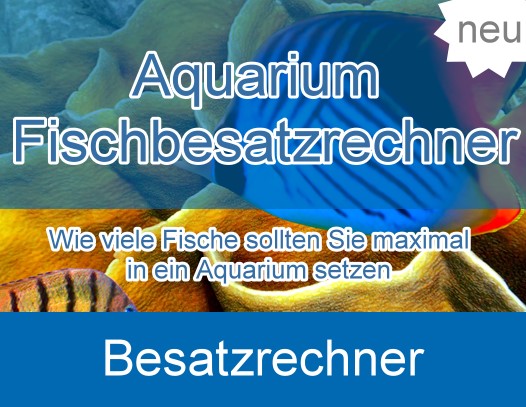What is the maximum number of aquarium fish allowed in an aquarium - Calculate Now
Ornamental fish for the aquarium
Once the fish were important staple food of mankind. In many regions even today people like to eat fish. Meanwhile, the fish fulfills another purpose. It serves as an ornament. A beautifully decorated aquarium with various ornamental fish is a feast for the eyes and gives its owner great pleasure. Since you can order ornamental fish online, the variety of species in domestic aquariums has become much greater. At the same time, such a tank is a sensitive ecosystem. The inhabitants are interdependent and must fit together. The keeper is responsible for creating ideal conditions for maintaining the habitat and keeping the animals species-appropriate.
Fish make more or less high demands on their habitat
Ornamental fish for the aquarium are numerous in the present. On the one hand they differ in appearance, on the other hand they require special husbandry. While some species are quite undemanding and suitable for beginners; these include barbs and catfish, others require careful care, which is determined by certain water values and temperatures. In this context, community tanks are popular, which provide space for several species of fish and plants. Their care is somewhat more complex, but with a little experience well manageable. Cichlids, tetras and catfish bring the necessary characteristics for peaceful coexistence in an aquarium. The tetra is peace-loving and can be kept with other fish.
More demanding fish include species that are aggressive and attack other inhabitants of the tank. The Brown Pufferfish has its own territory, which it defends vehemently against intruders. It can only be kept alone in a sufficiently large tank. Discus fish are recommended for so-called species aquariums, as they are susceptible to diseases in community tanks.
Both fish species are representative for keeping by experienced fish keepers who want to devote themselves to the care of a species and, if necessary, to breeding. They may also be enthusiastic about ordering ornamental fish online, because this allows the population to be fanned out more widely and fresh blood is always added to the tank.
When buying fish look carefully and take advantage of advice
Today it is possible to buy ornamental fish from all over the world. Thanks to the Internet, contacts can be made with breeders and dealers around the globe. This in turn means that rare species end up in European aquariums. If you want to specialize in rare and unusual fish, it is essential to find out in advance about any legal requirements. Some fish species are a highlight in the aquarium, however, some are endangered and may not be exported.
As far as possible, wild-caught fish should be avoided to protect the environment and the animal population. Fish that are suitable for aquarium keeping are usually offered in large numbers by breeders. Rare animals can also be found among them.
When composing the fish population in your own aquarium, consideration of the requirements of the individual fish is immensely important. Fish are differentiated according to freshwater, saltwater and brackish water fish. In addition, they sometimes have widely differing requirements in terms of water temperature and values. While some fish prefer cooler temperatures, others prefer it warm. Some fish can cope with temperature fluctuations without any problems. On the other hand, there are also species that require a constant water temperature.
Newcomers choose a slightly larger tank with a few easy to care for fish.
The beginner decides best for easy to maintain aquarium inhabitants. The trade offers an immense selection in this regard. In addition, ornamental fish can be ordered online. The size and quantity of the fish should be adapted to the aquarium accordingly. For starters, aquariums with a capacity of 100 to 200 liters are suitable, which have a manageable fish population. Smaller aquariums are more difficult to keep clean. As a result, the water quality suffers, which ultimately has a negative impact on the health of the fish. Water values in larger aquariums are easier to keep in the optimal range.
Some catfish species are also suitable for beginners
Low-maintenance fish include catfish, barbs, tetras and livebearing toothcarps. When selecting ornamental fish, make sure that the tank still provides adequate space for the fish when fully grown. The rule of thumb is 1.5 to two liters of water per centimeter of fish length, mind you the final fish length. For aquarium size, take the length of the largest fish times nine. If a fish size of six centimeters is expected, the aquarium must be at least 54 centimeters in width according to this rule. The dimensions are only a rough guideline.
Ultimately, the urge to move and the character of the fish also play a role. Catfish stay almost exclusively on the bottom. For them it is not about the water surface, they do not necessarily need a lot of space, but they like a varied base area, on which it is easy to dig.
What sizes of aquariums are there? Aquariums are available in the following sizes
-
50 liters - side length about 60 centimeters,
-
100 liters - side length about 80 centimeters,
-
200 liters - side length about 100 centimeters,
-
250/300 liters - side length about 120 centimeters,
-
400/450 liters - side length about 150 centimeters,
-
600 liters - side length about 180 centimeters and
-
over 1,000 liters - show aquariums, which are used only by breeders or in zoos and the like,
offered. Small and very large aquariums belong in the hands of experienced fish keepers. Alternatively, an aquarium can be made to your own desired dimensions.
Furthermore, fixtures and plants belong in the tank. They reduce the space again, which is accordingly to be considered when staffing with fish. Here, less is more. It is better to put in fewer fish that have enough space for them.
Before adding the fish, the water values must be checked. When the aquarium is newly set up, most values are initially in the green range. Nevertheless, you should check all values to be sure. A nitrite test is important. The nitrite must not be higher than 1-2 mg/l. If the required value is reached, the fish can move into the aquarium. Over time, continue to regularly check the pH, nitrate value, carbonate hardness, oxygen content and total hardness of the water.
Aquarium fish for beginners - Which fish in the aquarium?
An aquarium is a fascinating hobby that presents itself in a great variety. This makes it interesting for all ages and all levels of experience. Even a beginner can easily set up an appealing aquarium and provide fish with a species-appropriate habitat. If the conditions are right, even offspring will not be long in coming.
Beginners do not have to forego colorfulness and species richness
Numerous species also feel extremely comfortable in the hands of a beginner. In general, a sufficiently large tank, compatible inhabitants, a well thought-out interior design and ideal water values are important. A problem for many newcomers is the fight against algae. However, they can be kept under control with fish that are also easy to maintain. In the fight against algae, the new aquarist receives support from catfish and viviparous toothcarps.
Catfish in particular are known as "cleaners" in the aquarium. For the beginner, the Brown Antenna Catfish and some species of Corydoras are recommended. The Brown Antenna Catfish, still known as Blue Antenna Catfish in the trade, has proven to be very robust. It is easily satisfied in keeping and breeding.
The brown antenna catfish is kept in pairs. It reaches a size of up to 14 cm. To feel comfortable, the catfish needs an aquarium with at least 100 liters capacity. He prefers to stay on the bottom, so this should be varied with wooden roots to hide and scrape. In addition, the Brown Antenna Catfish breeds in cave hiding places. The Antenna Catfish can live up to 19 years.
The Antennae Catfish helps fight excessive algae growth
Of course, you don't want to have only fish scurrying around on the bottom and rather inconspicuous in color in your aquarium. You don't have to, because the beginning aquarist can choose from a rich selection of colorful fish. For example, there are the well-known tetras, which have several species ready in the most dazzling colors. Furthermore, barbs and perch species are well suited for the beginning.
The Siamese fighting fish is an eye-catcher in the aquarium
An extremely eye-catching fish, which is suitable for the beginner, is the Siamese fighting fish. It originates from the shallow, stagnant waters of Cambodia and Thailand. The fish are true survival artists. In their home country they have to cope with oxygen-poor and quickly warming water. Therefore they do not take beginner mistakes in the form immediately badly. Furthermore they have a small space requirement. They can be kept in aquariums from 50 liters.
The Siamese fighting fish prefers to live as a pair. The animals are strikingly red in color, with the body rather dark and the relatively large fins in bright red. They grow to a length of five to seven centimeters and reach an age of up to three years. As a living environment, the fish like a calm water surface with a cover of floating plants. In addition, the aquarium should be densely planted.
The group of perch species, which also thrive in beginner's hands, also includes
-
the African Butterfly Cichlid,
-
the paradise fish,
-
the Snail Cichlid and
-
the blue gourami.
The dwarf rainbowfish is the only representative of the spikefish species that is recommended for beginners. From the genus of carps, on the other hand, there is again a larger selection. Among others, the barbs can be found here. These fish also present themselves in many bright colors. The goldfish also belongs to the carp family. Although most people put it in the garden pond, it is also suitable for aquarium keeping.
Another family of fish are the tooth carps. The Platy, the Molly and the Guppy are the best known representatives of the same. The Platy is even represented by several species. The red platy and the coral platy have a strong orange-red, the blue Tuxedo platy has different shades of blue, the black platy has a predominantly black body with orange fins and the original platy is black and orange. Many platies are breedings of the original platy, which basically already has very interesting coloration. The various breedings have resulted in Platies of all colorations.
A large part of the presented species can be socialized with each other without any problems. A tank with catfish, characins, mollies and platies offers an interesting mixture. When putting the fish together, however, it is not just a matter of them being peace-loving. They also need to have the same habitat requirements.
Helpful tips for the aquaristic beginning
The decision for an aquarium has been made and you already know which fish it should be, now their housing must be designed. The planting and the substrate of the tank depend on the fish. The first step is to prepare the aquarium. Once this is done, perform a nitrite test. Test strips are commercially available for this purpose. The nitrite content must not exceed 1 to 2 mg/l. Nitrite is highly toxic for fish even in this low concentration.
If the nitrite test is positive, it is time for the future inhabitants to move in. At the beginning a manageable number of fish is sufficient. After one or two weeks, if no problems have occurred, the population can be increased. However, you may want to try your hand at breeding later on. If the fish are doing well, this usually happens on its own. Then it becomes automatically fuller in the basin. Therefore, you can start your life as an aquarist with a manageable population.
Similar Calculator Topics: Pets, aquaristics, fish, hobby, leisure


